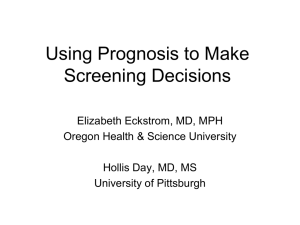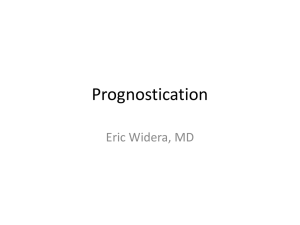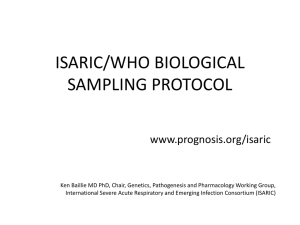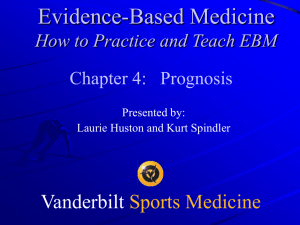Individualized Decision Making in the Elderly
advertisement
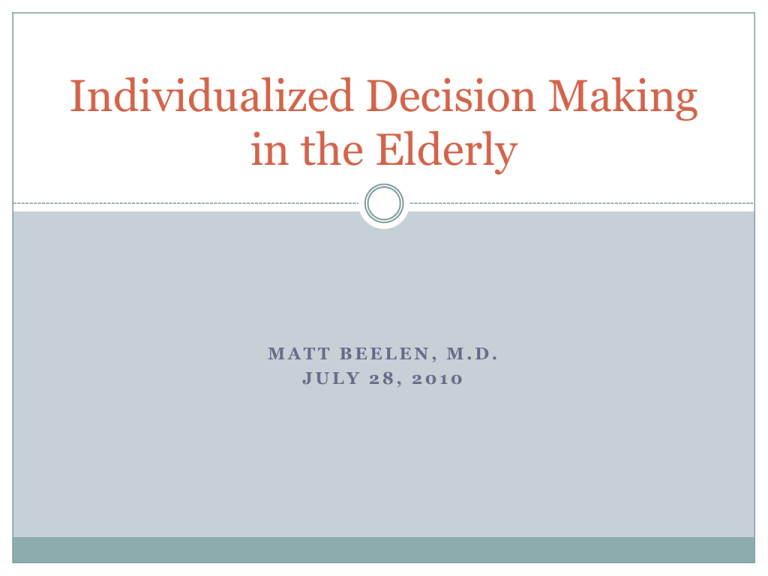
Individualized Decision Making in the Elderly MATT BEELEN, M.D. JULY 28, 2010 Introduction All elderly are not alike – divergence of aging Evidence-based guidelines fall short Age, exclusion criteria of studies We are still faced with clinical decisions we need to address As patients age, the burden of tests and treatments can continue to grow ? Diminishing returns How best can we make decisions in these circumstances? “Quality” of care, Quality of Life Individualizing Care: Objectives Given various clinical scenarios, you will: Estimate life expectancy Determine “time to benefit” Determine type and magnitude of harms/risks Determine type and magnitude of benefit Determine patient values and preferences Incorporate all of this information into a management plan Agenda Explain each of the objectives Demonstrate how to apply each of the objectives Practice applying the concept to clinical cases Time Based on the amount of time we expect the patient to live, will he/she live long enough to derive benefit from the test or treatment in question? What things will help in the time remaining? Life expectancy Time to benefit Life Expectancy How do we determine this? Start with a general estimate (population statistics) Modify based on: Comorbidities (and associated clinical data) Known illness trajectories Functional Status Symptoms Will to live Life Expectancy - General A starting point General health for age Excellent Average Poor Handout Comorbidities Number, status of, and symptoms related to significant medical conditions Dementia/Neurodegenerative Disease (Severity) Cerebrovascular disease/Stroke (Severity) Cardiac Disease (Type, NYHA Class) Pulmonary Disease (Stage, Gold Class) Renal Disease (Stage) Malignancy (Type, Stage, Grade) Diabetes (End Organ Disease) Known Illness Trajectory Disease specific Patient specific based on current clinical changes Functional Status ADL and IADL Status More useful for “non-palliative” elderly Palliative Performance Scale (derived from Karnofsky Performance Scale) – handout Correlates with survival, especially in palliative care population Validated in multiple studies For use in the general geriatric population it can be helpful to stratify into excellent-average-poor health status Prognosis – Heart Failure Unpredictable Trajectory NYHA Class and 1 year mortality Class II: 5-10%, Class III: 10-15%, Class IV 30-40% Other factors associated with limited prognosis: Recent cardiac hospitalization Increased BUN or Cr, Low Na or Hg SBP < 100, HR > 100, LVEF <45% Resistant ventricular dysrhythmias Cachexia, decreased functional capacity Comorbidities: DM, depression, COPD, liver, CVA, Cancer, HIV cardiomyopathy Reisfield GM. J Pall Med 2007;10:245-246. Prognosis - COPD Childers JW et al. J Pall Med 2007;10:806-807. Prognosis - Dementia Factors associated with worse prognosis Comorbidities (e.g. DM, CHF, COPD, cancer) Loss of physical function (related to dementia) Other complications and symptoms in advanced dementia Bowel incontinence Bed bound, asleep most of the time Weight loss, dysphagia, poor po intake Seizures, Hip fractures Pressure ulcers Dehydration Fever, aspiration, pneumonia Oxygen requirement, dyspnea See Mortality Risk Index Score Handout Tsai S. J Pall Med 2007;10:807-808. Mitchell SL et al. JAMA 2004;291:2734-2740. Prognosis – General Outpatient Elderly 4 and 5-year mortality: increased risk associated with Increasing age Male gender Comorbidities (DM, Ca, lung or heart disease, low BMI, smoker) Functional dependence (bathing, finances, walking several blocks, pushing/pulling heavy objects) Hospitalization in the last year Poor self-rated QOL Schonberg MA et al. J Gen Intern Med 2009;24:115-1122. Lee SJ et al. JAMA 2006;295:801-808. Prognosis: Discharge From Hospital Developed and validated in 3000 adults > age 70 Walter LC et al. JAMA 2001;285:2987-2994. Will to Live Different than patient preferences A “fighter” vs “ready to go anytime” Consider loss of spouse and family Consider spirituality, view of death and afterlife Consider “unfinished business” Consider what the person has to live for Is current QOL such that patient would like to prolong life? Practice - Life Expectancy Handout Ranges are probably most helpful < 5 years 2-5 years < 2 years What is type and extent of benefit? How can the test or treatment benefit the patient? Prevent cancer Detect and remove cancer (that may not be harming patient) Prevent death Prevent hospitalization Prolong life Decrease symptoms – pain Improve function, maintain independence Change lab values: LDL, A1C, Hg Time to Benefit How long does it take for a patient to realize the benefit of a test or treatment? Minutes to hours – pain relief from pain medication Years – mortality benefit of cancer screening Information usually comes from clinical trials that may not include patients like yours – only an estimate… Time to Benefit – Cancer Screening Time to mortality benefit Breast > 5 years Colon > 5-10 years Cervical Cancer 5-10 years Prostate > 10 years (if any benefit at all) Factors to consider Prior screening Risk factors (e.g. family history) Time to Benefit – Other Conditions Bisphosphonates for fracture prevention in osteoporosis: 1-2 years Statins for hyperlipidemia to prevent CV events: 1-2 years (<6 months if recent ACS) HTN meds to prevent stroke, CHF, CV events, death: 1-2 years Tight vs relaxed glucose control in diabetes to prevent macrovascular disease: 5-10 years SSRI for depressive symptoms: weeks Diuretics for fluid overload: hours to days Precision vs Estimate – many treatments unclear Type and Magnitude of Harms What is the negative side of testing or treatment? Financial cost (to anyone) Time, appointments Pill burden (and ECF issues) Pain, adverse effects, side effects Future ethical dilemmas: PEG tube, pacemakers Impact of false positive test results (physical, emotional) Impact on patients with dementia Time to harm: Harm could very likely come before benefit (e.g. hypoglycemia with DM meds) Putting it Together – Physician Agenda To help us focus our care efforts, we can consider Estimated life expectancy Potential harms and benefits Time to harm and benefit With increasing frailty: “Relax your agenda” See handouts Flaherty JH et al. J Am Geriatr Soc 2002;50:1886-1901. Reuben DB. JAMA 2009;302:2686-2694. Patient Values and Preferences Quality of life vs length of life Specific goals: remain at home, continue driving, limit medication side effects, avoid needles What kind of decision making does patient prefer: independent vs paternalistic Does patient/surrogate understand medical issues? What do we recommend? Based on intersection of medical information and patient preferences Putting it Together Eventually integrate into every patient encounter Many gray areas will remain Practice Use of this model in aging population is preferable to: Doing the same thing for everyone Using arbitrary age cutoffs routinely Over reliance on patient preference Over emphasis on physician agenda
